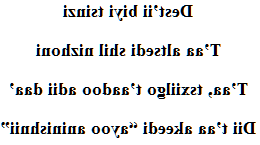Navajo love poem
Biiʼadéestʼı̨́ı̨́
Dest’ii biyi tsinzi
T’aa altsedi shil nizhoni
T’aa, tsxiilgo t’aadoo adii daa’
Dii t’aa akeedi “ayoo aninishnii”


→ French poem ←
Navajo woman & language
The Navajo language (Diné, Navaho, Autonym : Diné Bizaad, Naabeehó bizaad), is certainly, the best mirror of the Indians squaws, under their tipi. Navajo is in an apache language of the na dene family spoken fluently by 110,000 people.
Navajo is an Apache language found in these two states alongside others closely related Apache languages (jicarilla, mescalero, lipan), the Kiowa in Oklahoma is more different.
The language is well established, through many neighboring idioms in southern Athabaskan ... and there is mutual understanding between Navajo and these other languages, especially with the Western Apache languages. Yet the communities that speak these languages are very distinct, even culturally, and have been for four hundred years.
It is also important to note, that until the war, Navajo was the language of communication on the reserve, with many monolingual people. Today no more than 25% of children born learn it as their first language.
The term "Na-Dene" is due to Sapir (1915), which connects Tlingit and Haida (north-west) with Athabaskan languages. Subsequently he will add to this group the eyak. If there are similarities between these languages, it is impossible to say whether they are due to mere contact between the peoples who speak them.
Athabascan languages are found in three areas: North, Central Pacific, and South, linked to prehistoric north-south migrations. We find those in the north in Alaska and Canada, those on the Pacific coast between southern Oregon and northern California, and those in the south that concern us on this page in Arizona and New Mexico, where we can find the Navajos.
The Navajos
Navajos people call them Dine. In the southwest of the United States they represent, the second group of Amerindians, in the country, for the number. The navajo, like other Amerindian languages, was used during both wars; transmissions were coded with the navajo code.
The Navahos migrated from the sub-Arctic to the southwest of the United States, mainly in New Mexico and Arizona. They were influenced by the culture of the Pueblos, to which they borrowed many practices: horticulture, mode of filiation (exogamous matrilineal clans), magico-religious rituals, allied to ancient shamanistic practices.
A stanza from Kledze Hatal, a Navajo shaman song:
With beauty before me, may I walk.
With beauty behind me, may I walk
With beauty above me, may I walk
With beauty below me, may I walk
With beauty all around me, may I walk!
Niimi'ipuutímt